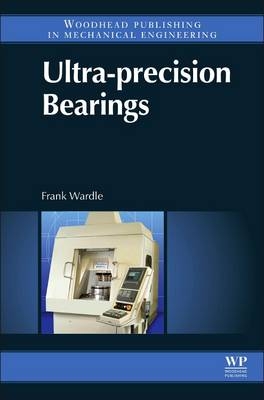
Ultra-precision Bearings
Woodhead Publishing Ltd (Verlag)
978-0-85709-162-8 (ISBN)
Ultra-precision bearings can achieve extreme accuracy of rotation, making them ideal for use in numerous applications across a variety of fields, including hard disk drives, roundness measuring machines and optical scanners. Ultraprecision Bearings provides a detailed review of the different types of bearing and their properties, as well as an analysis of the factors that influence motion error, stiffness and damping. Following an introduction to basic principles of motion error, each chapter of the book is then devoted to the basic principles and properties of a specific type of bearing: ball, hydrodynamic, aerodynamic, hydrostatic and aerostatic. The book concludes with a comparison of these types of bearing and their applications.
Frank Wardle is Managing Director of UPM Ltd – a research and development company specialising in Ultra Precision equipment. He has more than 30 years of practical experience in bearing research, initially with the rolling bearing companies Ransom, Hoffman and Pollard (RHP) and SKF and later with the air bearing manufacturer Loadpoint Ltd. Throughout this period he was not only responsible for research into ways of improving bearing performance, but also for developing new commercial bearing designs and some of the machinery used for their manufacture and testing.
List of figures and tables
Preface
About the author
1. Introduction
Abstract
1.1 Benefits of ultra precision bearings
1.2 A systems approach
1.3 Bearing motion error
1.4 Static stiffness
1.5 Damping
1.6 The bearing as a dynamic machine element
1.7 Thermal characteristics
1.8 Closure
1.10 Notation
2. Ball bearings
Abstract
2.1 Scope
2.2 Bearing sections
2.3 Bearing arrangements
2.4 Bearing tolerances
2.5 Ring fits and mounting parameters
2.6 Ball bearing load–deflection characteristics
2.7 Static stiffness characteristics of ball bearings
2.8 Damping in ball bearings
2.9 Motion error
2.10 Power consumption and thermal distortion
2.11 Life and reliability
2.12 Closing remarks
2.13 Appendix 2A, Vibration forces generated by waviness on the rolling surfaces of thrust bearing ball bearings
2.15 Notation
3. Hydrostatic bearings
Abstract
3.1 Introduction
3.2 Bearing description
3.3 Basic operating principles
3.4 Pocket geometries
3.5 Hydrostatic bearing arrangements
3.6 Types of compensation
3.7 Approximate load capacity and static stiffness
3.8 Oil flow through a narrow gap
3.9 Temperature dependence of oil viscosity
3.10 Bearing load and deflection characteristics
3.11 Damping
3.12 Motion error
3.13 Power consumption and heat generation
3.14 Reliability
3.16 Notation
4. Aerostatic bearings
Abstract
4.1 Introduction
4.2 Bearing geometries and arrangements
4.3 Principle of operation
4.4 Types of compensation
4.5 Approximate load capacity and static stiffness
4.6 Load–deflection analysis
4.7 Mass flow rate of air through an orifice
4.8 Mass flow rate of air through a porous insert
4.9 Grooved and recessed bearings
4.10 Porous air bearings
4.11 Air bearing static stiffness characteristics
4.12 Damping and dynamic stability
4.13 Motion error
4.14 Thermal characteristics
4.15 Reliability
4.17 Notation
5. Hydrodynamic herringbone and spiral grooved bearings
Abstract
5.1 Introduction
5.2 Bearing types
5.3 Operating principles
5.4 Past developments
5.5 Load–deflection analysis of annular thrust bearings
5.6 Annular thrust bearing design examples
5.7 Radial load–deflection analysis of herringbone grooved journal bearings
5.8 Load capacity and static stiffness characteristics of herringbone grooved journal bearings
5.9 Damping and dynamic stability
5.10 Motion error
5.11 Thermal characteristics
5.12 Overview
5.14 Notation
6. Aerodynamic herringbone and spiral grooved bearings
Abstract
6.1 Introduction
6.2 Bearing types
6.3 Past developments
6.4 Static load capacity and stiffness of aerodynamic annular thrust bearings
6.5 Design example
6.6 Static load capacity and stiffness of aerodynamic herringbone grooved journal bearings
6.7 Example of static stiffness and load capacity
6.8 Damping and dynamic stability
6.9 Thermal characteristics
6.10 Overview
6.12 Notation
Index
| Erscheint lt. Verlag | 19.2.2015 |
|---|---|
| Verlagsort | Cambridge |
| Sprache | englisch |
| Maße | 156 x 234 mm |
| Gewicht | 780 g |
| Themenwelt | Informatik ► Weitere Themen ► CAD-Programme |
| Technik ► Maschinenbau | |
| ISBN-10 | 0-85709-162-X / 085709162X |
| ISBN-13 | 978-0-85709-162-8 / 9780857091628 |
| Zustand | Neuware |
| Haben Sie eine Frage zum Produkt? |
aus dem Bereich


